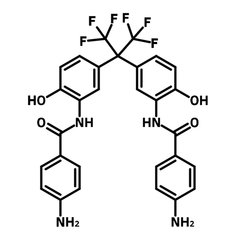p-6FDAP
CAS Number 129197-38-2
Chemistry Building Blocks, COF Ligands, Diamines and Dianhydrides, Fluorinated Building Blocks,A fluorinated diamine intermediate
For the synthesis of polyimides in application of telecommunication and high-performance polymers
Specifications | MSDS | Literature and Reviews
2,2-Bis[3-(4-aminobenzamido)-4-hydroxyphenyl]hexafluoropropane (CAS number 129197-38-2), known as p-6FDAP, has two terminal aminobenzamides linked to a bis(dihydroxyphenyl)hexafluoropropane. p-6FDAP is commonly used for synthesizing polyimides, especially those with low dielectric constant. A pedant group, such as biphenyl can be easily attached to the polymer backbone with the unreacted hydroxy groups. The molecular design is to obtain extra volume in bulk by the secondary relaxation behavior of the polymers. Therefore, the dielectric constant of the grafted polyimides can reach 2.09 with dielectric loss of 0.0012 at 10 kHz. The grafted polyimides derived from p-6FDAP are ideal for telecommunication applications.
p-6FDAP based polyimides can be further functionalized by polymerizable groups, for instance acrylate, allowing they to be crosslinked for higher thermal resistance (5% decomposition temperature from 455 °C to 491 °C)
Multiple functional groups
For facile synthesis
Fluorinated diamine building block
For high-performance polymers, COFs, and polyamides
Worldwide shipping
Quick and reliable shipping
High purity
>99% High purity
General Information
| CAS Number | 129197-38-2 |
| Chemical Formula | C29H22F6N4O4 |
| Full Name | 2,2-Bis[3-(4-aminobenzamido)-4-hydroxyphenyl]hexafluoropropane |
| Molecular Weight | 604.51 g/mol |
| Synonyms | 4-Amino-N-[5-[2-[3-[(4-aminobenzoyl)amino]-4-hydroxyphenyl]-1,1,1,3,3,3-hexafluoropropan-2-yl]-2-hydroxyphenyl]benzamide, N,N'-((Perfluoropropane-2,2-diyl)bis(6-hydroxy-3,1-phenylene))bis(4-aminobenzamide) |
| Classification / Family | Fluorinated building blocks, Diamine building blocks, Polyimides, Telecommunication, High-performance polymers |
Chemical Structure

Product Details
| Purity | >99% |
| Melting Point | Not Known |
| Appearance | White powder/crystal |
MSDS Documentation
Literature and Reviews
-
Facile strategy for intrinsic low-k dielectric polymers: molecular design based on secondary relaxation behavior, C. Qian et al., Macromolecules, 52(12), 4601–4609(2019); DOI: 0.1021/acs.macromol.9b00136.
-
Composite ferroelectric coating based on a heat-resistant polybenzoxazole polymer matrix, N. Mukhin et al., Coatings, 10, 286(2020); DOI: 10.3390/coatings10030286.
-
Low dielectric constant polymers for high speed communication network, L. Wang et al., Advanced Industrial and Engineering Polymer Research, 3, 138-148(2020); DOI: 10.1016/j.aiepr.2020.10.001.
